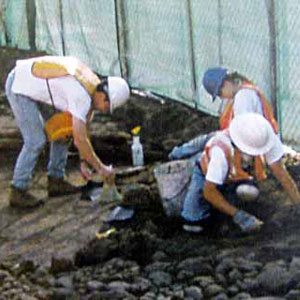A Look Back
(1931 – 2001)

- In 1931, the initial archaeological excavation of the remains of the original adobe was conducted by Miller with the assistance of high school students. This led to efforts to have the site declared a Federal Monument. The attempt failed because a portion of the remains was on private property.
- The construction of the Universal City subway station necessitated the excavation of the Campo de Cahuenga foundation. In order to protect the historic site, which was directly adjacent to the construction project, the Metropolitan Transit Authority authorized Greenwood & Associates, a professional archaeological firm, to undertake the excavation in 1996.
- The discovery of mission period floor tiles led to the reappraisal of the age of the Campo. It had been largely accepted that the Campo foundation was the Tomas Feliz adobe that had been constructed in the 1840s. However, secularization of the missions had occurred in 1834 and the manufacture of the floor and roof tiles had to be produced at mission kilns that ceased operation after secularization. Further historical research sponsored by the MTA determined that Mission San Fernando was using the site by 1810.
- Mariano de la Luz Verdugo, a pensioned Spanish soldier, obtained grazing rights to the Campo in 1783. In 1797 Mission San Fernando was established 13 miles to the north of the site. In 1810 Verdugo relinquished control of the Campo to the mission. It is believed the Campo was used to support the mission’s ranching operations.
- Exposed for analysis today are the original mission period floor tiles and the stone foundation on which the adobe walls were constructed. Gradually the adobe fell into disrepair. In 1877 U.S. Army surveyor John Goldsworthy recorded the adobe house. By the turn of the century the adobe walls had melted away leaving “nothing but a small knoll around which are a few brick” to mark the site.
- The adobe foundations are now known to extend in front of the Campo site, under busy Lankershim Boulevard. As the technology of archaeology develops, further excavations may yield greater knowledge of the site.